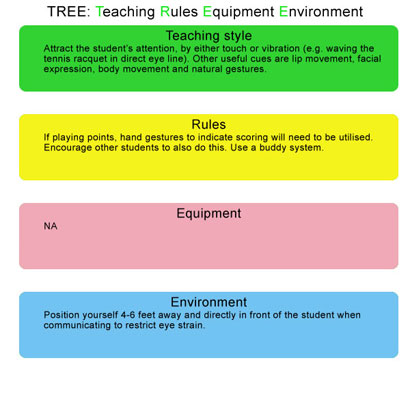Deaf Players
Coaching
Here are some tips that will assist coaches with coaching hearing-impaired players:
- Where possible, demonstrate techniques rather than rely on verbal explanations. In order to conduct effective demonstrations, coaches shoulder present one or two key points of a skill at a time and use athletes where possible to demonstrate.
- Display information visually wherever possible.
- If a deaf person does not reply or seems to have difficulty in understanding, rephrase what you just said or demonstrated before moving on.
- Ask the deaf person to teach you sport specific signs.
- Don’t make the deaf person stand out.
- Ensure that the deaf athlete/s can identify essential signals in tennis; a simple example could include a coach putting an arm up, then down at the same time as the whistle.
- It will be useful to discuss the general hints described above to the group members, parents and/or associates prior to or shortly after the deaf person joining the group. The coach can also educate referees about what can be done to assist the deaf person.
- Use the TREE model in coaching (see below).
Tennis modifications
Try making the following modifications:
- A few extra seconds should be taken, where practical, to explain the coach’s/referee’s decisions to the deaf athlete.
- Coaches/referees can use visual signs to gain the attention of a deaf person during competition using flags or basic gesturing such as waving.
- A deaf person might need attention from the coach/referee when requesting an explanation about a rule during play. It is more likely the deaf person will touch the coach/referee on his/her shoulder for attention. It is an acceptable thing for deaf people to do.
Communication tips
Try these communication tips:
- Don’t be afraid to ask the deaf person how they would like to communicate.
- Stand where a deaf person can clearly see your face. Speak clearly without shouting, and with normal inflection and timing.
- Attract the deaf person’s attention by tapping them on the shoulder or waving before speaking to them.
- Display information visually wherever possible.
- Confirm that your message is understood.
- Learn Australian Sign Language (Auslan). Contact Deaf Sports Australia or your State Deaf Society to find out where to start.
TREE
TREE (Teaching Rules Equipment Environment) is an instant way of remembering how to modify the activity – deaf.
 Contacts
Contacts
Deaf Sports Australia – Irena Farinacci
E: [email protected]
W: www.deafsports.org.au
Deaf Tennis Australia – Stephan Swann
E: [email protected]
W: www.deaftennisaustralia.org

